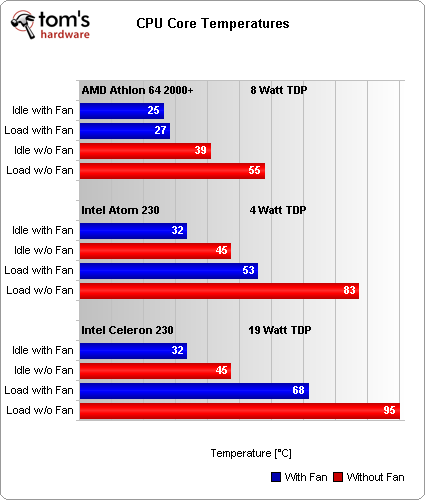Athlon Vs. Atom: Duel Of The Energy Savers
Cooling And Temperature
Since the Athlon 64 2000+ is a desktop processor, a commonly-available cooler can be used. For the test we used the boxed cooler, which usually comes with the 45 watt Sempron LE-1100 and its cooling element is made completely out of aluminum. Since the cooling power of the cooler is enormous compared to the heat released from the processor, we only measured a temperature difference of 2 °C between idle and full load operation. With the fan turned on, the temperature does not exceed 27 °C.
Here we have disconnected the fan and removed the frame.
Because of the size of the cooler in comparison to the energy consumption of the Athlon 64 2000+, we measured the temperature after one hour of operation. With just the passive aluminum cooling element, the core temperature stays at 39 °C while the processor is idle; at full load, it does not exceed 55 °C after one hour.

The 780G chipset, due to its low energy consumption, can be sufficiently cooled using only two small coolers. The Athlon 64 2000+, with its relatively low performance, limits the onboard graphics, and thus the integrated GPU never operates at high-load conditions, so the northbridge can be run without active cooling. Just to be sure, we ran Gigabyte’s GA-MA78GM-S2H board with the AMD Athlon 64 2000+ for over 12 hours at 100% CPU load without problems.
Get Tom's Hardware's best news and in-depth reviews, straight to your inbox.
Current page: Cooling And Temperature
Prev Page Chipset Comparison: AMD vs. Intel Next Page System Power Consumption-
wh3resmycar oh please, spare me those kind of crap...Reply
clearly the 780g platforms owns any nvidia/intel chipset to date.
about the article:
this is a winner, i mean this is like the ultimate HTPC setup you can ever have.no heat/power worries just plain movie enjoyment :D -
photoguru wow... good choices for matching mobos... why even take the time to write these articles? If you're comparing HTPCs that are low cost, efficient, and fast enough for encoding and decoding then do it with the right gear. Don't tell me that an ultra mobile processor just got pwned by a desktop chip unless they figured out how to make that desktop chip fit in an ultra mobile form factor.Reply
It doesn't make sense to compare them on those terms unless your entire argument is based on wattage and not actual form factor performance.
I will say that it would be interesting to find out what combination of low cost parts makes the most reasonable HTPC as far as performance/cost goes (with watts and temps included in case we could passively cool these babies). -
guusdekler Tom's choice of AMD hardware is a bit shortsighted in my opinion.Reply
There exist a lot more options that the matx board of his choice.
Let me name some of the MINI-ITX boards there are for AMD AM2 AM2+:
- Albatron KI690-AM2
- AOpen NMCP68ST-LA
- JetWay NC62K-LF
- MSI Fuzzy 690T
Allricht they employ a different chipset than the 780G but still very competetive as i derive this information from a dutch hardware magazine that tested these boards against intel's solution and especially the AOpen and MSI boards beat the crap out of intel's D201GLY2 board. -
apache_lives see this is what AMD is all about!!!!!!!!!!!Reply
Intel - produces first generation, limited, expensive and unflexible setups, AMD creates a cheaper flexible option for the masses, which kicks Intel back in line.
This opens the low power platform up to all new ideas, and allows vista to run properly thanks to the video performance etc, and ram support.
Nice one AMD! -
Wow! great, I hope next time, in 45 nm AMD will bring 2 phenom in one socket and become the new Phenom X8(like Intel pentium D) its just kick the new Intel Core i7. He, he, he...Reply
-
venteras I agree with photoguru, this is a pointless comparison. If you don't use the same form factor, i.e. mini-itx for both of them then what's the point? Unless if you want to disregard size and only compare performance/watt. However, since the whole point of the ATOM is to go 'smaller'... yeah, whatever.Reply
-
nottheking I must say I'm a bit surprised at the results. It's good to see that perhaps there's more life (and use) left in Athlon64s than we'd previously thought, if they make ideal low-power CPUs. Likewise, it's a surprise to find a place where AMD trumps Intel in the performance-per-watt sector, which is always important; I can perhaps imagining chips like the 2000+ and Atom being used for low-maintenance servers and datacenters, where PPW has always outweighed raw performance, since it's infinitely easier to buy more chips than to upgrade the local power grid.Reply
Now, if only Intel would develop an Atom-specific chipset that didn't consume copious amounts of memory. If AMD can get low-end GPU power sufficient for high-def decoding (regardless of what the CPU is) in under a single watt, certainly Intel could make a chipset that can handle all that is done by the 945GC and its laughable GMA 950 in even less power, since we're talking a less-complex design that has considerably less graphics power on hand, as well as the fact that Intel has access to 45nm production right now, while AMD is still stuck with 55nm. If only the chipset for an Atom didn't have several times the thermal envelope of the CPU...

